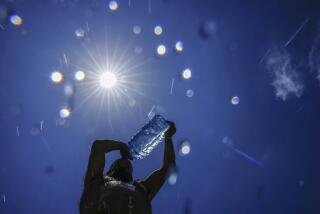Flush point
- Share via
VIVIAN AIZAWA of Salinas vividly remembers the first time her body was hit by a heat wave out of the blue -- an episode of warmth, flushing and sweating that “almost felt like climate change,” the 53-year-old says. The hot flashes and night sweats affected her sleep and strained her relationships. “It is ruining my life,” she told her doctor.
Nearly three out of four women will share Aizawa’s experience as they go through menopause. Many, in fact, will get hot flashes and night sweats several times a day for years, each episode lasting from a few seconds to several minutes.
For the record:
12:00 a.m. July 27, 2007 For The Record
Los Angeles Times Friday July 27, 2007 Home Edition Main News Part A Page 2 National Desk 1 inches; 62 words Type of Material: Correction
Hot flashes: A July 23 Health article on remedies for hot flashes said that a study led by Johns Hopkins Medicine researchers found that women who have hot flashes could have oversensitive serotonin receptors. The statement was a theory based on rat studies -- not a finding -- included in a review of hot flash studies written by the Johns Hopkins researchers.
For The Record
Los Angeles Times Monday, July 30, 2007 Home Edition Health Part F Page 7 Features Desk 1 inches; 61 words Type of Material: Correction
Hot flashes: An article in last week’s section on hot flashes said that a study led by Johns Hopkins Medicine researchers found that women who have hot flashes may have oversensitive serotonin receptors. The statement was a theory -- not a finding -- based on rat studies included in a review of hot flash studies written by the Johns Hopkins researchers.
“It impacts literally millions of women worldwide,” says Dr. Wulf Utian, president of the Ohio-based North American Menopause Society, a nonprofit that promotes menopause research. “While not life-threatening, it is a major impediment to their quality of life.”
For relief, women have tried dozens of remedies: herbs, low-fat diets, antidepressants. Then, in 1942, came a major advance. The U.S. Food and Drug Administration approved Premarin, a form of the female sex hormone estrogen extracted from horse urine. Since then, extensive studies have shown that the hormone, either alone or in combination with other sex hormones, really works: It relieves moderate to severe symptoms in 90% of women who take estrogen.
But hormone therapy does not suit all women; those with a family history of early breast or ovarian cancer, for instance, probably have to avoid it. And many others have concerns about long-term estrogen use, especially in the years since the landmark Women’s Health Initiative trial, which reported a few years back that hormones slightly raised the risk of not only breast cancer but also heart attacks and strokes. (See “Hormones: Is age the key?”)
Others are willing to take the hormone but suffer unpleasant side effects such as breast tenderness and vaginal discharges. “For these women, the cure is worse than the problem,” says Dr. Nananda Col, associate professor of medicine at Brown Medical School in Providence, R.I.
And so researchers are looking for alternatives -- substances that can calm sweats and flashes while presenting fewer risks. They have identified some possible candidates -- drugs such as the antidepressant venlafaxine, the steroid tibolone and the anticonvulsant gabapentin -- and trials are underway to evaluate some of them. At the same time, scientists are gaining a better understanding of what actually causes hot flashes.
In hot surroundings, humans cool their bodies in two ways: by sweating, which dissipates heat by evaporation, or by flushing, which cools heated blood by circulating it through dilated blood vessels in the skin.
In hot-flash sufferers, both responses are often inappropriately triggered by signals from the hypothalamus, the part of the brain that regulates temperature. When this occurs, there is a discrepancy between the woman’s sensation of warmth and her actual body temperature.
Old studies using thermometers placed in the mouth, ear or rectum failed to detect a temperature change during a hot flash. More recent studies, using ingested thermometers, show that there is often a core temperature change, but a small one: less than one-tenth of a degree Fahrenheit. This increase precedes 60% of hot-flash episodes.
How this tiny thermal spike could trigger such an intense feeling of warmth is less clear, though. Further, small temperature fluctuations occur even in women who don’t get hot flashes. Evidently, some women tolerate body temperature fluctuations better than others.
To explain how this could be, Dr. Robert Freedman, professor of psychiatry at Wayne State University School of Medicine in Detroit, has devised the notion of a “thermoneutral zone,” the range of body temperatures a person endures comfortably. It’s sandwiched between a “sweating threshold,” above which one feels too hot, and a “shivering threshold,” below which one feels too cold.
The size of this zone in younger, non-menopausal women is about one degree, but in hot-flash sufferers it shrinks to almost zero, Freedman has found. Even a minuscule spike in temperature pushes the body over the sweating threshold, triggering a hot flash. “You’ve got no play in the system in these women,” Freedman says.
What causes this loss of heat tolerance is still a mystery. Earlier researchers put the blame squarely on the loss of estrogen during menopause, but now scientists think that the picture may be more complex. For one thing, researchers have found no connection between a hot-flash episode and the sufferer’s estrogen level at that moment. Also, there is no difference between estrogen levels of hot-flash sufferers and other menopausal women.
Finally, although estrogen is nearly 90% effective in treating hot flashes, it doesn’t work for everyone. “Hormone deficiency is one factor but not the whole deal,” Freedman says.
In their search for a more direct cause -- and new remedies -- researchers have zeroed in on activity of the brain-signaling chemicals norepinephrine and serotonin inside the hypothalamus. Freedman’s studies suggest that levels of norepinephrine are higher in women who get hot flashes. Another study led by Johns Hopkins Medicine researchers in Baltimore found that these women may also have oversensitive serotonin receptors.
Either factor could reduce the body’s ability to tolerate temperature variations , researchers say.
These changes might explain why venlafaxine, an antidepressant that regulates brain levels of both chemicals, is about 60% effective in reducing the frequency or severity of hot flashes. Medically classified as a Serotonin-Norepinephrine Reuptake Inhibitor, or SNRI, venlafaxine so far has been evaluated for hot flashes in small-scale and short-term clinical trials; larger and longer-duration trials are now underway.
Studies show that other antidepressants such as fluoxetine (Prozac), which regulates serotonin alone, are also effective, but somewhat less so. “The SNRIs are a very promising avenue,” says Dr. Andrea Rapkin, professor of obstetrics and gynecology at UCLA and author of a recent review paper on non-hormonal hot-flash therapies.
Another drug that appears to increase the body’s tolerance of temperature fluctuations is tibolone, a steroid that mimics the effects of estrogen and other sex hormones. Available in Europe but not approved by the FDA for use in the U.S., tibolone has been shown in some small-scale studies to be effective in treating hot flashes. A clinical trial of the drug in Mexico with 200 subjects is expected to finish in 2008.
The anticonvulsant drug gabapentin is another potential treatment. A 2005 study found that the drug was effective at higher doses in reducing the severity and frequency of hot flashes in women with breast cancer.
But few experts believe that any of these non-estrogen remedies will replace hormone therapy as the standard treatment for menopausal symptoms. None of the drugs matches estrogen in effectiveness, and all carry their own side effects.
Further, none of these drugs has yet been validated in trials that match the vast scale, scope and duration of the estrogen studies.
Despite the slightly elevated risk of heart disease, stroke and breast cancer, hormone therapy remains the best option for the majority of recently menopausal women, says Dr. JoAnn Manson, professor of medicine at Harvard Medical School in Boston and a lead investigator in the Women’s Health Initiative study. “It would be unfortunate for women with distressing symptoms to avoid this treatment for fear of very rare risks,” she says.
For Aizawa, whose hot flashes often made her very irritable with her husband and colleagues, the choice was clear: estrogen. “The well-being of my life mattered more,” she says.
--
(BEGIN TEXT OF INFOBOX)
What’s been tried
There have been plenty of disappointments in the quest for alternative hot-flash remedies.
Black cohosh, an herb long considered a hot-flash/night-sweats remedy, failed to alleviate symptoms either on its own or combined with other herbs in a study published last December. The study, published in the Annals of Internal Medicine, tracked 351 women who were given different herbal regimens and found that the number of hot-flash episodes they experienced were no different than those of participants receiving a placebo.
Soy, red clover and isoflavone supplements have also disappointed in most studies.
Some non-drug remedies seem to help. A 2005 study in the Journal of the American Medical Assn. reported that nearly two-thirds of women who stopped taking hormones experienced a recurrence of symptoms but that many were able to alleviate them with non-drug approaches such as yoga and other forms of exercise.
Women suffering symptoms may also find it helpful to sleep in a cool room, wear lightweight and layered clothing, practice breathing exercises and avoid alcohol and spicy foods.
-- Rosie Mestel






